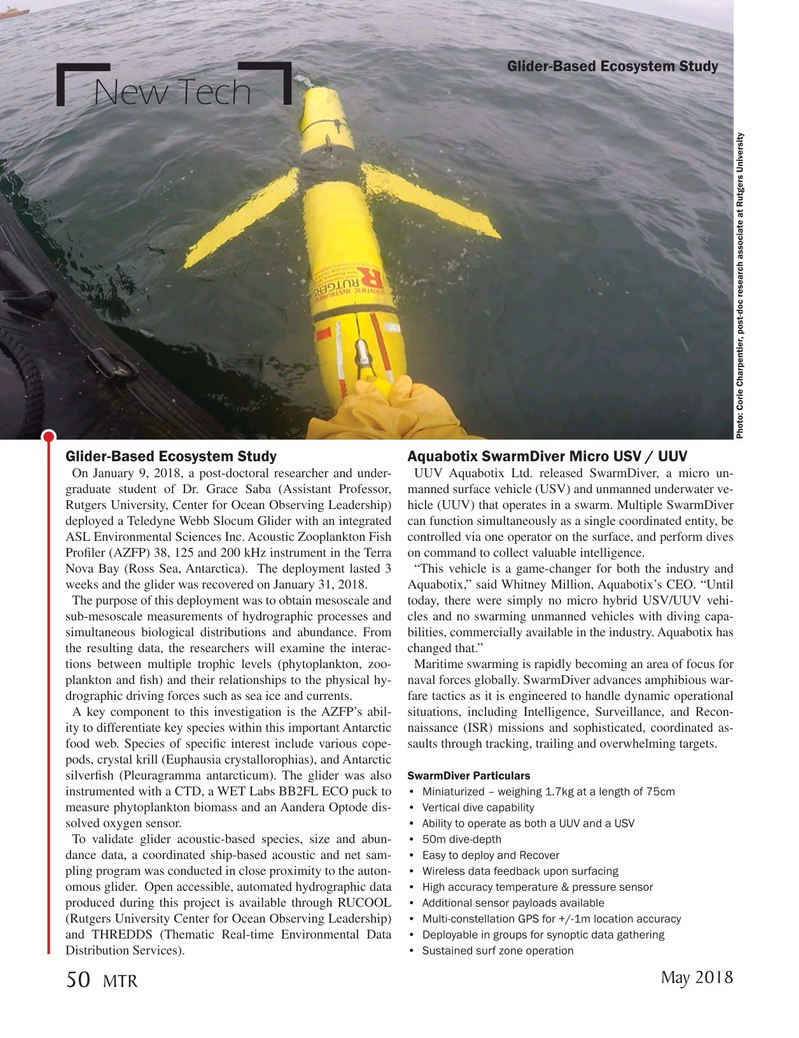
Page 50: of Marine Technology Magazine (May 2018)
Hydrographic Survey: Single beam and Multibeam Sonar
Read this page in Pdf, Flash or Html5 edition of May 2018 Marine Technology Magazine
Glider-Based Ecosystem Study
New Tech
Photo: Corie Charpentier, post-doc research associate at Rutgers University
Glider-Based Ecosystem Study Aquabotix SwarmDiver Micro USV / UUV
On January 9, 2018, a post-doctoral researcher and under- UUV Aquabotix Ltd. released SwarmDiver, a micro un- graduate student of Dr. Grace Saba (Assistant Professor, manned surface vehicle (USV) and unmanned underwater ve-
Rutgers University, Center for Ocean Observing Leadership) hicle (UUV) that operates in a swarm. Multiple SwarmDiver deployed a Teledyne Webb Slocum Glider with an integrated can function simultaneously as a single coordinated entity, be
ASL Environmental Sciences Inc. Acoustic Zooplankton Fish controlled via one operator on the surface, and perform dives
Pro? ler (AZFP) 38, 125 and 200 kHz instrument in the Terra on command to collect valuable intelligence.
Nova Bay (Ross Sea, Antarctica). The deployment lasted 3 “This vehicle is a game-changer for both the industry and weeks and the glider was recovered on January 31, 2018. Aquabotix,” said Whitney Million, Aquabotix’s CEO. “Until
The purpose of this deployment was to obtain mesoscale and today, there were simply no micro hybrid USV/UUV vehi- sub-mesoscale measurements of hydrographic processes and cles and no swarming unmanned vehicles with diving capa- simultaneous biological distributions and abundance. From bilities, commercially available in the industry. Aquabotix has the resulting data, the researchers will examine the interac- changed that.” tions between multiple trophic levels (phytoplankton, zoo- Maritime swarming is rapidly becoming an area of focus for plankton and ? sh) and their relationships to the physical hy- naval forces globally. SwarmDiver advances amphibious war- drographic driving forces such as sea ice and currents. fare tactics as it is engineered to handle dynamic operational
A key component to this investigation is the AZFP’s abil- situations, including Intelligence, Surveillance, and Recon- ity to differentiate key species within this important Antarctic naissance (ISR) missions and sophisticated, coordinated as- food web. Species of speci? c interest include various cope- saults through tracking, trailing and overwhelming targets. pods, crystal krill (Euphausia crystallorophias), and Antarctic
SwarmDiver Particulars silver? sh (Pleuragramma antarcticum). The glider was also • Miniaturized – weighing 1.7kg at a length of 75cm instrumented with a CTD, a WET Labs BB2FL ECO puck to • Vertical dive capability measure phytoplankton biomass and an Aandera Optode dis- • Ability to operate as both a UUV and a USV solved oxygen sensor.
• 50m dive-depth
To validate glider acoustic-based species, size and abun- • Easy to deploy and Recover dance data, a coordinated ship-based acoustic and net sam- • Wireless data feedback upon surfacing pling program was conducted in close proximity to the auton- • High accuracy temperature & pressure sensor omous glider. Open accessible, automated hydrographic data • Additional sensor payloads available produced during this project is available through RUCOOL • Multi-constellation GPS for +/-1m location accuracy (Rutgers University Center for Ocean Observing Leadership) • Deployable in groups for synoptic data gathering and THREDDS (Thematic Real-time Environmental Data • Sustained surf zone operation
Distribution Services).
May 2018 50
MTR
MTR #4 (50-63).indd 50 MTR #4 (50-63).indd 50 5/10/2018 12:23:57 PM5/10/2018 12:23:57 PM

 49
49

 51
51
